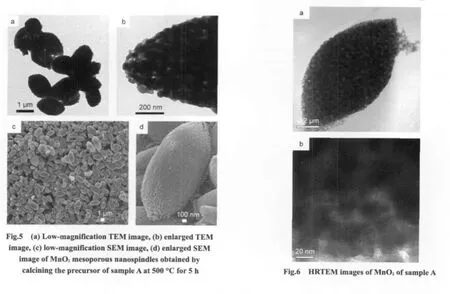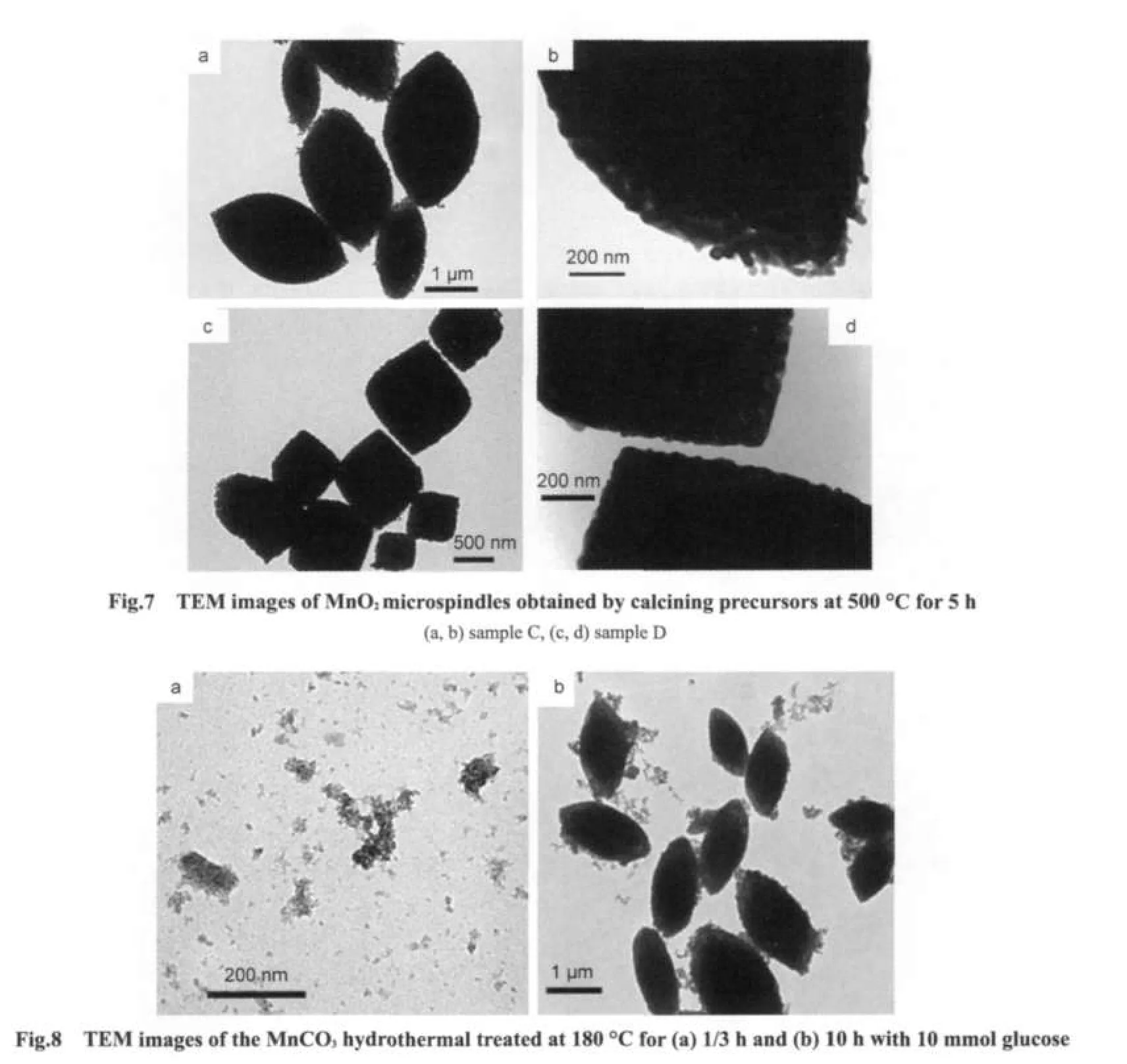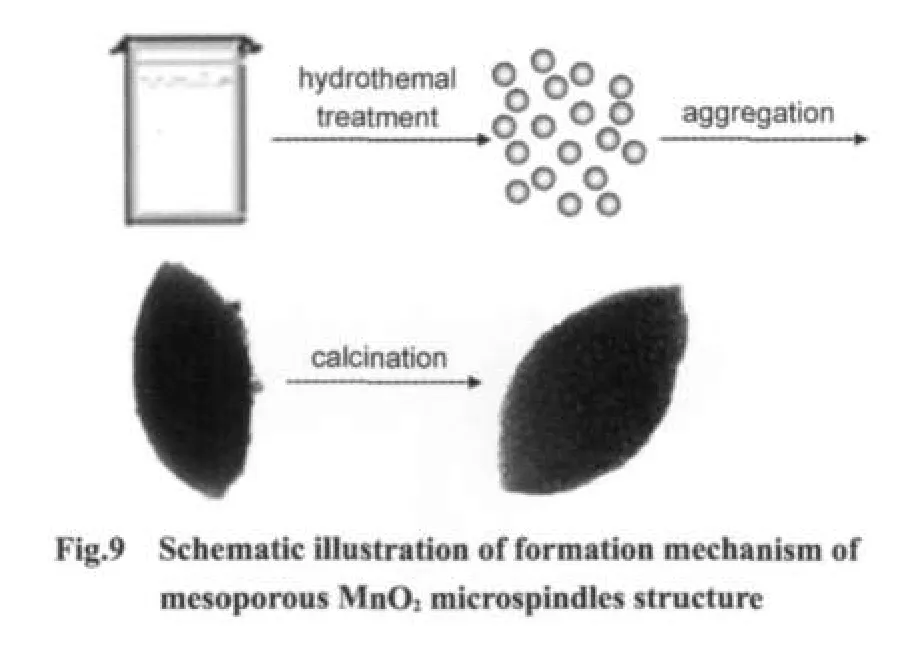Controlled Synthesis of Mesoporous MnO2Nanospindles
HAN Ling NI Ji-Peng ZHANG Liang-Miao YUE Bao-Hua SHEN Shan-Shan ZHANG Hao LU Wen-Cong
(Department of Chemistry,Shanghai University,Shanghai 200444,P.R.China)
Controlled Synthesis of Mesoporous MnO2Nanospindles
HAN Ling NI Ji-Peng ZHANG Liang-Miao YUE Bao-Hua SHEN Shan-Shan ZHANG Hao LU Wen-Cong*
(Department of Chemistry,Shanghai University,Shanghai 200444,P.R.China)
Abstract: We synthesized mesoporous MnO2nanospindles by a one-step hydrothermal process in an aqueous solution of KMnO4and glucose.The structure,morphology,purity,and size of the products were characterized by X-ray diffraction(XRD),Fourier transform infrared(FTIR)spectroscopy,transmission electron microscopy(TEM),high resolution transmission electron microscopy(HRTEM),scanning electron microscopy(SEM),and nitrogen adsorption/desorption(BET)measurements.The reaction time and concentrations of glucose influenced the final structures and shapes of the MnO2nanospindles.The length to diameter ratio of the MnCO3precursor nanospindles can be easily tuned from 1.35:1 to 2.89:1.A possible formation mechanism for the mesoporous MnO2nanospindles is proposed and discussed.
Key Words:Hydrothermal method;Spindle;MnO2;Mesoporous
1 Introduction
Recently,much effort has been devoted to the synthesis of mesoporous materials,because of their wonderful structures and wide potential applications in the areas of catalysis,sorption,chemical and biological separation,photonic and electronic devices,and drug delivery.1-5Since the mesoporous silica was reported,6many researchers have devoted to preparing mesoporous-structured oxides,such as ZrO2,TiO2,SnO2,Nd2O5,and V2O5,etc.1-5Thus,mesoporous products with controlled structures and shapes remain a new challenge because of their possible potential functions caused by the combination of the specific-shape and the mesoporous structures.7
Manganese oxides(MnO2)have been extensively studied as a well-known transition-metal oxide,because of their novel chemical and physical properties and wide applications in catalysis,ion or molecular sieves,molecular adsorption,biosensors,electrode materials in batteries,and energy storage.8-18MnO2exists in many polymorphic forms(such asα,β,γ,andδ),which are different because the basic unit[MnO6]octahedra are linked in different ways.19,20Different MnO2morphologies have been prepared,including rods,wires,tubes,urchin-like microstructures,etc.21-25However,to the best of our knowledge,few works were reported on the synthesis of mesoporous MnO2nanospindles.
Herein,we report the synthesis of mesoporous MnO2nanospindles using a simple hydrothermal method followed by heat treatment.By changing the experimental conditions,we rationally speculated that,the formation of pores was mainly caused by removing of amorphous carbon nanoparticles,which were produced due to the decomposition of residual glucose at a relatively higher temperature.

Table 1 Effects of the experimental conditions on the morphologies of the precursors
2 Experimental
All chemical reagents were analytical grade and purchased from Shanghai Chemical Reagent Company(P.R.China)without further purification.In a typical synthesis,10 mmol glucose was dissolved in 25 mL deionized water,and 2 mmol potassium permanganate(KMnO4)was dissolved in 15 mL deionized water.After stirring for about 30 min respectively,the two solutions were mixed immediately before it was sealed and placed in a Teflon-lined stainless steel autoclave(50 mL capacity)and heated at 180°C for 20 h.The autoclave was cooled to room temperature naturally.After filtrating and washing with deionized water and ethanol,the solid obtained was dried at 60 °C overnight and calcined at 500 °C for 4 h.The obtained black powder was collected for the following characterization.Effects of the experimental conditions on the morphology of the precursors are showed in Table 1.
The XRD patterns were recorded on a Japan Rigaku D/Max-RB X-ray diffractometer with CuKαradiation(λ=0.154178 nm).The morphologies of the samples were studied by field emission scanning electron microscopy(JEOL JSM-6700F).The structure of the microspindles was observed through a transmission electron microscopy(JEOL JEM-200CX),and the highresolution transmission electron microscopy(HRTEM)images were taken on a JEOL JEM-2010F with an accelerating voltage of 200 kV.Fourier transform infrared(FTIR)spectra were obtained on an AVATAR370 spectrometer.The nitrogen adsorption and desorption isotherms at 77 K were measured with a Micrometrics ASAP 3000 analyzer.Before measurement,the samples were degassed in vacuum at 200°C for at least 6 h.
3 Results and discussion
The XRD pattern of the precursor is shown in Fig.1(a).The peaks can be well indexed to manganese carbonate(MnCO3),in good agreement with the standard value of JCPDS 44-1472.Fig.1(b)shows FTIR spectrum of the precursor.The broad band at about 3370 cm-1can be attributed to O―H group vibrates from the residual hydroxy groups.26The peak at 2924 cm-1is assigned to C―H band,27suggesting the possible incorporation of hydrogen during growth of the product.The peak at 1698 cm-1can be assigned to the C=C stretch,28resulting from the carbonization of residual glucose.The typical peaks for carboxylate are found at ca.1602,1406,860,and 789 cm-1.The first two frequencies correspond to the stretching mode of C=O in a carboxylate group and the last two refer to bending mode.29While the bands observed at 520-700 cm-1should be ascribed to the Mn―O vibrations in MnO6octahedra.30

Field emission scanning electron microscopy(FESEM)and field emission transmission electron microscopy(FETEM)were employed to investigate the morphologies of the products.Fig.2(a)shows a typical low magnification image of the MnCO3precursor spindles,the obtained products are composed of the nanospindles mixed with a few of sphere-like par-ticles.The magnified SEM image shown in Fig.2(b)displays that the surfaces of the spindles are rough and some nanoparticles are adsorbed on them.Fig.2(c)is a typical TEM image of the MnCO3spindles.The average size of the MnCO3spindles is 2023 nm along its major axis and 950 nm along its minor axis,and the length-to-diameter ratio is about 2.12:1.
Keeping other experimental conditions fixed,the effect of the reaction temperature was investigated.When the reaction was carried out at 150°C(sample B),the obtained product was also composed of spindle-like structures mixed with few sphere-like particles(Fig.3a).In comparison with the product obtained at 180°C(sample A),the average dimensions of nanospindles(obtained at 150 °C)are 2670 nm×1230 nm and the aspect ratio is increased(2.17:1).However,when the reaction was carried out at a relatively lower temperature of 120°C(sample C),the product was only composed of nanospindles with average dimensions of 2800 nm×1200 nm and the aspect ratio was obviously increased(2.35:1)(Fig.3b).

In addition,the glucose concentration plays an important role in forming nanostructure.When the concentration of glucose is low(nG=4 mmol),only spindle-like structure with average dimensions of 1350 nm×1000 nm was obtained(sample D,Fig.3c).In comparison with the product obtained at nG=10 mmol(sample A),the aspect ratio of sample D is reduced(1.35:1).When the concentration of glucose is high(nG=16 mmol),thecantaloupe-likestructuresmixed with some sphere-like particles were obtained(Fig.3d).The average size of the cantaloupe-like structures is 1865 nm along its major axis and 643 nm along its minor axis,and the length-to-diameter ratio is obviously increased(2.89:1).
Based on the above observation,when the reaction was carried out at relatively higher temperatures(150-180°C)and higher glucose concentration(nG:nKMnO4≥5:1),there are some sphere-like structures obtained.It is rationally speculated thatthe spheres were produced due to the decomposition of residual glucose at relatively higher reaction temperatures.

MnO2nanostructures are expected to be obtained by calcining the precursors at a proper temperature.Fig.4(a)shows the XRD pattern of the samples obtained by calcining the MnCO3precursors at 500°C for 4 h.The diffraction lines are in agreement with the standard value(JCPDS No.44-0141)of MnO2with body-centered structure,indicating the MnCO3precursor completely transforming to MnO2.More characteristics of MnO2are also observed in FTIR spectrum(Fig.4b).The broad band at about 3477 cm-1can be attributed to O―H group vibrates from the residual hydroxy groups.31The 1640 cm-1band is normally due to O―H bending vibrations combined with Mn atoms.32While the intense bands observed at 669,573,and 522 cm-1should be ascribed to Mn―O vibrations in MnO6octahedra.30The FTIR result indicates that some bound water exists in MnO2sample.As compared with the as-prepared compound(Fig.1(b)),the disappeared peaks correspond to C=C,C―H,and C=O confirm the existence of carbon particles in the precursors.
TEM and SEM images of the MnO2nanostructures are shown in Fig.5 and Fig.6.After heat-treatment,the spindle-like shapes of the precursors were well maintained,no obviously sintered or compressed phenomena were observed(Fig.5a and Fig.5b).Fig.5c shows that most particles are spindle-like.Fig.5d clearly displays the three-dimensional spindle-like morphology with the disappearance of spheres in the precursors and the mesoporous nanospindles which composed of small nanoparticles.The disappearance of the sphere-like structures further indicates that the spheres in sample A,B,E were amorphous carbon spheres produced due to the decomposition of residual glucose at relatively higher reaction temperatures.From the HRTEM results in Fig.6a and Fig.6b,we can see that the MnO2sample exhibits mesoporous structure and that the distribution of the pore structure is regular.
Fig.7 shows TEM images of MnO2nanospindles obtained by calcining different precursors.After heat-treatment,the spindle-like shapes of the precursors(sample C and D)were well maintained.But there are only few pores along the side of the spindle-like structures for sample C(Fig.7(a,b)),and no pores were observed for sample D(Fig.7(c,d)).It indicates that the reaction temperature,especially glucose concentration plays important roles in the formation of mesoporous nanostructures.When the reaction temperature is below 120°C or the glucose concentration is low(nG:nKMnO4=2:1),the mesoporous structure can not be obtained.It demonstrates that the formation of pore structure,to some extent,is caused by removing amorphous carbon nanoparticles.It is rationally speculated that the precursors of mesoporous MnO2nanospindles are composed of carbon nanoparticles and MnCO3nanoparticles.
To further investigate the formation process of the nanospindle superstructure as the above conjecture,we have carried out analogous experiments at different reaction durations.For these spindles,when the hydrothermal reaction was conducted for 1/3 h,many amorphous nanoparticles were produced.A few small nanoparticles were loosely aggregated,and these aggregations may act as backbones for the further development of MnCO3spindle structures(Fig.8a).When the reaction time was increased to 10 h,a few nanoparticles(Fig.8b)and many solid spindle particles composed of nanoparticles were produced.As the reaction went on to a longer time(e.g.,20 h),the size of the spindles(sample A)has grown larger in all direc-tions and the size uniformity is greatly improved(Fig.2).


After heat-treatment,the carbon nanoparticles were disappeared and MnCO3was decomposed to mesoporous MnO2nanospindles.So the possible formation mechanism of MnO2nanospindles structure can be presumed in Fig.9.
Nitrogen adsorption/desorption measurement was conducted to characterize the Brunauer-Emmett-Teller(BET)surface area and internal pore structure.The recorded adsorption and desorption isotherms for the nanospindle structures show a little hysteresis(Fig.10).The BET specific surface area of the sample is calculated from N2isotherms to be about 26 m2·g-1.Barrett-Joyner-Halenda(BJH)calculations for the pore-size distribution,derived from desorption data,present a sharp band centered at ca 18 nm.The pores presumably arise from the spaces between the nanoparticles within a mesoporous spindle.The results display that the obtained nanospindles have porous properties.


4 Conclusions
By adopting a stepwise reaction process,the MnCO3precursor nanospindles have been prepared via a facile solution process,and the dimension and morphology of the MnCO3precursors can be adjusted.Mesoporous MnO2nanospindles obtained by calcining the precursors are considered to arise from the appearance of the carbon nanoparticles.The micro-spindles after heat treatment exhibit porous properties which make them appealing for practical applications such as catalysts,molecular adsorption,biosensors,and energy storage.
(1)Carreon,M.A.;Guliants,V.V.Chem.Mater.2002,14,2670.
(2) Schuth,F.Chem.Mater.2001,13,3184.
(3)Yang,P.D.;Zhao,D.Y.;Margolese,D.I.;Chmelka,B.F.;Stucky,G.D.Nature 1998,396,152.
(4)Yang,P.D.;Zhao,D.Y.;Margolese,D.I.;Chmelka,B.F.;Stucky,G.D.Chem.Mater.1999,11,2813.
(5) He,X.;Antonelli,D.Angew.Chem.Int.Edit.2001,41,214.
(6) Kresge,C.;Leonowicz,M.;Roth,W.;Vartuli,J.;Beck,J.Nature 1992,359,710.
(7) Gu,F.;Li,C.Z.;Wang,S.F.;Lu,M.K.Langmuir 2006,22,1329.
(8) Espinal,L.;Suib,S.L.;Rusling,J.F.J.Am.Chem.Soc.2004,126,7676.
(9) Armstrong,A.R.;Bruce,P.G.Nature 1996,381,499.
(10) Song,X.C.;Zheng,Y.F.;Lin,S.;Wang,Y.Acta Phys.-Chim.Sin.2007,23,258.[宋旭春,鄭遺凡,林 深,王 蕓.物理化學學報,2007,23,258.]
(11)Winter,M.;Brodd,R.J.Chem.Rev.2004,104,4245.
(12)Toupin,M.;Brousse,T.;Belanger,D.Chem.Mater.2002,14,3946.
(13)Wang,T.;Zhou,J.H.;Wang,D.J.;Sun,D.;Di,Z.Y.;He,J.P.Acta Phys.-Chim.Sin.2009,25,2155.[王 濤,周建華,王道軍,孫 盾,狄志勇,何建平.物理化學學報,2009,25,2155.]
(14)Wills,A.S.;Raju,N.P.;Greedan,J.E.Chem.Mater.1999,11,1510.
(15) Segal,S.R.;Park,S.H.;Suib,S.L.Chem.Mater.1997,9,98.
(16)Greedan,J.E.;Raju,N.P.;Wills,A.S.;Morin,C.;Shaw,S.M.;Reimers,J.N.Chem.Mater.1998,10,3058.
(17)Wang,F.;Wang,Y.M.;Wen,Y.X.;Su,H.F.;Li,B.Acta Phys.-Chim.Sin.2010,26,521.[王 凡,王巖敏,文衍宣,粟海峰,李 斌.物理化學學報,2010,26,521.]
(18) Deng,J.G.;Zhang,L.;Dai,H.X.;Xia,Y.S.;Jiang,H.Y.;Zhang,H.;He,H.J.Phys.Chem.C 2010,114,2694.
(19) Cheng,F.Y.;Zhao,J.Z.;Song,W.;Li,C.S.;Ma,H.;Chen,J.;Shen,P.W.Inorg.Chem.2006,45,2038.
(20)Wang,X.;Li,Y.D.J.Am.Chem.Soc.2002,124,2880.
(21)Wang,X.;Li,Y.D.Chem.-Eur.J.2003,9,300.
(22) Xiong,Y.J.;Xie,Y.;Li,Z.Q.;Wu,C.Z.Chem.-Eur.J.2003,9,1645.
(23)Wei,M.;Konishi,Y.;Zhou,H.;Sugihara,H.;Arakawa,H.Nanotechnology 2005,16,245.
(24)Yuan,Z.Y.;Ren,T.Z.;Du,G.H.;Su,B.L.Appl.Phys.AMater.2005,80,743.
(25) Song,X.C.;Zhao,Y.;Zheng,Y.F.Cryst.Growth.Des.2007,7,159.
(26) Xiong,Y.J.;Xie,Y.;Li,X.X.;Li,Z.Q.Carbon 2004,42,1447.
(27)Wong,W.K.;Li,C.P.;Au,F.C.K.;Fung,M.K.;Sun,X.H.;Lee,C.S.;Lee,S.T.;Zhu,W.J.Phys.Chem.B 2003,107,1514.
(28)Chowdhury,A.K.M.S.;Cameron,D.C.;Hashmi,M.S.J.Thin Solid Films 1998,332,62.
(29)Ho,C.M.;Yu,J.C.;Kwong,T.;Mak,A.C.;Lai,S.Y.Chem.Mater.2005,17,4514.
(30)Ananth,M.V.;Pethkar,S.;Dakshinamurthi,K.J.Power Sources 1998,75,278.
(31) Liu,Z.H.;Yang,X.J.;Makita,Y.;Ooi,K.Chem.Mater.2002,14,4800.
(32)Wang,X.L.;Yuan,A.B.;Wang,Y.Q.J.Power Sources 2007,172,1007.
紡錘形介孔納米二氧化錳的控制合成
韓 玲 倪紀朋 張良苗 岳寶華 申杉杉 張 浩 陸文聰*
(上海大學化學系,上海200444)
在KMnO4和葡萄糖水溶液體系中,用一步水熱法控制合成了介孔MnCO3納米紡錘體,通過焙燒MnCO3前驅體可以得到介孔納米MnO2,且保持了原有的紡錘體形貌.用X射線衍射(XRD)、傅里葉變換紅外(FTIR)光譜、掃描電鏡(SEM)、透射電鏡(TEM)和N2吸附-脫附(BET)對制備的樣品進行了形貌和結構的表征.并對反應時間、反應物濃度等對產物形貌的影響進行了研究.實驗結果表明,反應時間和葡萄糖的濃度對MnCO3前驅體的尺寸和形貌具有重要影響,MnCO3縱橫比可從1.35:1到2.89:1之間改變.并初步探討了介孔MnO2紡錘體的生長機制,MnO2孔的形成是由于焙燒葡萄糖降解形成的納米碳顆粒所致.
水熱法;紡錘形;MnO2;介孔
O641
Received:September 27,2010;Revised:November 15,2010;Published on Web:January 28,2011.
?Corresponding author.Email:wclu@shu.edu.cn;Tel:+86-21-66132663;Fax:+86-21-66134080.
The project was supported by the Shanghai Special Nanotechnology Project,China(0852nm00700)and Innovation Fund of Shanghai University,China(A.10-0101-09-023).
上海市納米技術項目(0852nm00700)和上海大學創新項目(A.10-0101-09-023)資助

